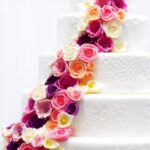Are you looking to step up your cake decorating game? Learn how to decorate cake with ganache for a delicious and beautiful finish. Ganache is a versatile and delectable option for decorating cakes, adding both flavor and visual appeal. In this article, we will explore the process of using ganache to create stunning cake decorations, covering everything from making the ganache itself to troubleshooting common issues.
Ganache is a decadent combination of chocolate and cream that can be used in various ways to decorate cakes, from creating smooth, elegant finishes to adding intricate designs. Whether you’re a beginner or an experienced baker, mastering the art of cake decorating with ganache can take your creations to the next level. So let’s dive in and discover the beauty of using ganache as a cake decoration.
In the following sections, we will discuss the tools and ingredients you’ll need to get started, provide a step-by-step guide on making ganache, explore different techniques for applying it to your cake, and offer creative ideas for adding decorative touches with ganache. With this comprehensive guide, you’ll be well-equipped to create stunning ganache-decorated cakes for any occasion.
Getting Started
When it comes to decorating a cake with ganache, having the right tools and ingredients is key to achieving a professional-looking finish. Before you begin, make sure you have the following items on hand:
- Heavy cream: This is the main ingredient used to make ganache. Make sure you use heavy cream with a high fat content for the best results.
- Chocolate: Whether you prefer dark, milk, or white chocolate, make sure you choose a high-quality chocolate for your ganache.
- Butter: Adding a small amount of butter to your ganache can help give it a glossy finish and improve its texture.
- Double boiler or microwave: You’ll need a way to melt your chocolate and cream together, either using a double boiler on the stovetop or by microwaving in short intervals.
- Spatula: A good spatula will help you to mix and spread your ganache evenly onto your cake.
- Cake turntable: While not essential, using a cake turntable can make it easier to apply the ganache smoothly and evenly.
In addition to these basic ingredients and tools, you may also want to consider adding flavorings such as liqueurs or extracts, as well as food coloring if you want to tint your ganache. Once you have everything ready, you’ll be all set to start making and applying your delicious ganache.
Step-by-Step
Ganache is a versatile and delicious way to decorate cakes, providing a smooth and glossy finish that adds an elegant touch to any creation. Making ganache is surprisingly simple, requiring just a few basic ingredients and a little bit of technique. In this section, we’ll walk through the step-by-step process of making ganache so you can achieve the perfect consistency for decorating your cake.
Ingredients and Tools
To make ganache, you’ll need just two main ingredients: chocolate and heavy cream. The type of chocolate you choose will affect the flavor of your ganache, so opt for high-quality chocolate for best results. You’ll also need a saucepan, heatproof bowl, and whisk for heating and mixing the ganache.
Heating the Cream
The first step in making ganache is heating the heavy cream. In a saucepan, gently warm the cream over medium heat until it begins to simmer. Be careful not to let it boil, as this can cause it to scorch.
Mixing With Chocolate
Once your cream is heated, pour it over finely chopped chocolate in a heatproof bowl. Allow the mixture to sit for a few minutes to give the heat from the cream time to melt the chocolate. Then, gently whisk the mixture together until it becomes smooth and glossy.
By following these steps, you can easily create a luscious ganache that is perfect for decorating cakes and adding a touch of luxury to your baked creations. The possibilities are endless when it comes to using ganache to decorate cakes, so don’t be afraid to experiment with different flavors and techniques.
Preparing the Cake
When it comes to decorating a cake with ganache, choosing the right base is crucial to achieving the perfect end result. The type of cake you use will not only affect the taste and texture of your creation but also how well it holds up under the weight of the ganache. Here are some key points to consider when preparing the cake for ganache decoration.
Cake Type
The first decision to make when choosing a base for your ganache-decorated cake is the type of cake itself. While any type of cake can be used, certain varieties work better than others. For example, a dense and sturdy cake like chocolate or pound cake is ideal for holding up against the weight of thick ganache, while a lighter and more delicate sponge cake may require extra care during application.
Cake Shape and Size
Consider the shape and size of your cake when preparing it for ganache decoration. A flat-topped cake will provide a smooth canvas for applying ganache, while a domed cake may require leveling before adding the ganache. Additionally, make sure to choose a size that matches the serving needs and aesthetic preferences of your creation.
Leveling and Crumb-Coating
Before applying ganache, it’s important to ensure that your cake is level and free from crumbs. Use a long serrated knife or a leveling tool to even out any domed tops or uneven layers. Once leveled, consider giving your cake a thin layer of frosting or ganache as a crumb coat to seal in any loose crumbs before adding the final layer of ganache.
By carefully considering these factors when preparing your cake for ganache decoration, you can set the stage for a stunning and delicious finished product that will delight both the eyes and taste buds.
Applying the Ganache
Once you’ve made your ganache, it’s time to apply it to your cake. The key to a beautifully decorated cake lies in achieving a smooth finish with the ganache. There are several techniques you can use to ensure that your cake looks as perfect as it tastes.
One popular method for applying ganache involves pouring it over the cake and allowing it to flow down the sides, creating a seamless, glossy coating. This technique works best with thin or runny ganache and is often used on single-layer cakes or for creating a “drip” effect on multi-layer cakes.
Another common approach is using an offset spatula to spread the ganache evenly over the top and sides of the cake. This allows for more precision and control, resulting in a clean, polished look. For those looking to achieve sharp edges on their cake, using a bench scraper can help create straight lines and a professional finish.
No matter which technique you choose, working with ganache requires patience and attention to detail. Take your time and don’t rush the process – the result will be well worth the effort. Remember that practice makes perfect, so don’t be discouraged if your first attempt isn’t flawless.
| Technique | Description |
|---|---|
| Pouring Method | Pouring ganache over the cake for a seamless, glossy finish |
| Offset Spatula | Using an offset spatula for precise spreading of ganache |
| Bench Scraper | Utilizing a bench scraper for sharp edges and a professional look |
Adding Decorative Touches
Decorating a cake with ganache offers endless possibilities for creativity and personalization. Once you have mastered the art of applying ganache to your cake, it’s time to explore various decorative touches that will take your creation to the next level. Here are some creative ways to use ganache to adorn your cake:
- Top with Fresh Fruit: Add a pop of color and freshness to your ganache-decorated cake by topping it with an assortment of fresh berries, sliced kiwi, or edible flowers. The combination of rich chocolate ganache and vibrant fruits creates a visually stunning contrast.
- Drizzle with Caramel or Chocolate Syrup: Elevate the appearance and flavor of your cake by drizzling caramel or chocolate syrup over the ganache. The glossy sheen from the syrup adds an elegant touch, making your cake look even more delectable.
- Piping Designs: Use a piping bag fitted with a decorative tip to pipe intricate designs on the surface of the ganache. You can create swirls, rosettes, or even personalized messages using contrasting colors of ganache for a stunning visual impact.
Adding decorative touches to your ganache-decorated cake allows you to showcase your individual style and creativity. Whether you opt for simplicity with fresh fruit or go for elaborate designs using piping techniques, these creative embellishments will undoubtedly impress your guests.
Experimenting with different decorative elements will help you discover unique ways to enhance the overall aesthetic appeal of your ganache-decorated cakes. Don’t be afraid to let your imagination run wild and try out various ideas until you achieve the perfect embellishment for your masterpiece.
Troubleshooting
Decorating a cake with ganache can be a fun and rewarding experience, but it’s not without its challenges. Fortunately, most common issues that arise when working with ganache can be easily fixed with a few simple techniques.
One of the most common problems is ganache that is too runny or thin, which can make it difficult to achieve a smooth finish on your cake. To fix this issue, simply let the ganache sit at room temperature for a bit to thicken up before using it.
On the other hand, if your ganache is too thick and difficult to spread, you can try warming it up slightly in the microwave or over a double boiler to loosen it up. It’s important to do this slowly and carefully, as overheating the ganache can cause it to become grainy.
Another issue that often comes up when working with ganache is air bubbles forming on the surface of the cake after applying the ganache. To prevent this, try using a palette knife or bench scraper to smooth out the surface of the ganache before it sets.
Another common problem when working with ganache is achieving a glossy finish on your cake. If your ganache is looking dull instead of shiny, try adding a bit of corn syrup or glucose to the mixture before heating it. Additionally, you can try gently heating the surface of the ganached cake with a hot knife or blow torch to bring out its shine.
| Common Issue | How to Fix |
|---|---|
| Ganache is too runny or thin | Letting it sit at room temperature to thicken up |
| Ganvhe is too thick and difficult to spread | Warming it slightly in the microwave or over a double boiler |
| Air bubbles forming on surface of cake after applying | Use palette knife or bench scraper to smooth out surface before it sets |
Serving and Storing
After you have beautifully decorated your cake with ganache, it’s important to ensure that it is served and stored correctly to maintain its appearance and taste. Whether you are presenting your cake at a special occasion or saving it for later enjoyment, here are some tips for serving and storing your ganache-decorated creation.
When serving your ganache-decorated cake, it’s important to consider the temperature. Ganache has a tendency to soften at room temperature, so if you’re displaying the cake for an event, make sure the room is cool and well-ventilated. If possible, refrigerate the cake until just before serving to help maintain the shape of the ganache.
For storing your ganache-decorated cake, refrigeration is key. Store the cake in an airtight container to prevent any absorption of odors from other foods in the refrigerator. If you’ve used perishable fillings or frostings in your cake, make sure it is stored in the refrigerator to keep it fresh.
When ready to enjoy, let the cake sit at room temperature for about 30 minutes before serving to allow the ganache to slightly soften for optimal taste and texture. By following these simple tips for serving and storing your ganache-decorated cake, you can ensure that it looks as beautiful as when it was first created.
Conclusion
In conclusion, decorating a cake with ganache is a versatile and delightful way to add flavor and style to your sweet creations. Whether you’re a beginner or an experienced baker, the smooth and glossy finish of ganache can elevate any cake to a professional level. With the right tools, ingredients, and techniques, you can easily master the art of using ganache to decorate your cakes.
The beauty of ganache lies in its adaptability. Whether you want to create a classic chocolate-covered cake or experiment with different flavors and decorative touches, ganache offers endless possibilities for creativity. From simple, elegant designs to intricate and eye-catching decorations, ganache can be used in various ways to suit any occasion or theme.
As you embark on your next baking adventure, we hope this guide has inspired you to explore the world of decorating with ganache. With the knowledge and skills gained from this article, you have the foundation to create stunning cakes that not only look impressive but also taste absolutely delicious. So go ahead, unleash your imagination and let ganache be the canvas for your next show-stopping creation.
Frequently Asked Questions
How Long Do You Leave Ganache Before Putting on Cake?
Ganache should be left to set for about 2-4 hours before putting it on a cake. This allows it to thicken and become spreadable without being too runny, ensuring that it will adhere well to the cake without sliding off.
What Consistency Should Ganache Be to Cover a Cake?
The consistency of ganache should be smooth, creamy, and thick enough to coat the back of a spoon. It should not be too thin or too thick, as this could affect its ability to evenly cover the cake without dripping excessively.
Is It Better to Cover a Cake in Ganache or Buttercream?
Whether to cover a cake in ganache or buttercream depends on personal preference and the desired outcome. Ganache provides a rich and indulgent flavor with a glossy finish, while buttercream offers a softer texture and can be easily flavored or colored.
Some bakers even opt for using both, with ganache as a base layer and buttercream as a final coating for decoration. Ultimately, the choice between ganache and buttercream comes down to the taste and texture you want for your cake.

Welcome to my blog about home and family. This blog is a place where I will share my thoughts, ideas, and experiences related to these important topics. I am a stay-at-home mom with two young children. I hope you enjoy reading it! and may find some helpful tips and ideas that will make your home and family life even better!





